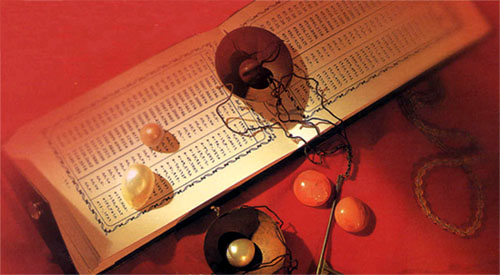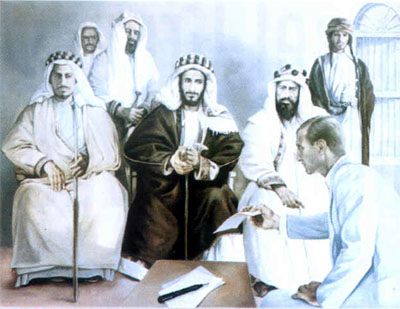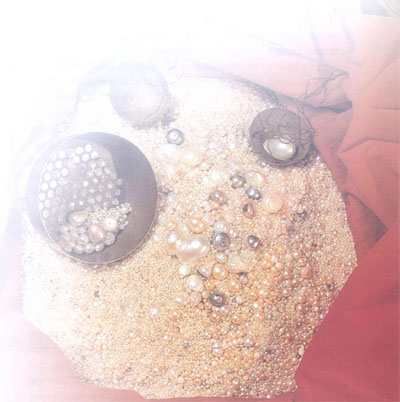|

The
simple life that people in the gulf had
prior to the oil era – mainly in the
thirties and forties of last century - did
not deter several persons from achieving
fame in various fields, including
literature, trade and science. The will of
man was the only motive that brought a
certain degree of prosperity to the
society. Pearl industry, and some
dignitaries played an essential role in
establishing schools, inspired by the
emergence of a reform movement and
supported by some Arab leaders and
intellectuals.
The only form of education in the late
nineteenth and early twentieth centuries
was concentrated in Kuttabs, which
flourished in mosques and taught its
students some reading and writing through
reciting the Holy Quran. Khalaf Bin
Abdulla Al Otaiba was a famous peal
merchant, but he will be mostly remembered
because he opened the first semi-official
school in
Abu
Dhabi
.
Khalaf was born in 1840, and at the age of
60, he became a famous and wealthy pearl
merchant (Tawwash), in addition to being
the sheikh of his tribe, Al Otaibat. It
was a branch of Al Marar tribe, which in
turn was one of the four major allies that
composed Bani Yas. It is noteworthy that
Bani Yas is the tribe of Al Nahyan, Rulers
of Abu Dhabi, as well as Al Maktoum (or Al
Bu Falasa), Rulers of Dubai.
Khalaf Bin Abdulla Al Otaiba
had very close relation with other famous
dignitaries, such as Shaikh Ali Bin
Mohammed Al Mahmoud, Ahmed Bin Dalmouk,
Salem Bin Mussabah Bin Hamoudah. He was
also a friend of Emir Abdulla Bin Jelwi,
Prince of the Eastern Zone in
Saudi
Arabia
and used to visit him frequently in Al
Ahsa’a that witnessed at that time a
significant progress in the field of
education. Many students from the Trucial
States (presently UAE),
Oman
and other Gulf areas used to come to
Ahsa’a to attend schools there.
The fame of Gulf pearls was one of the
main attractions of the region. By the
beginning of the 20th century huge fleets
of pearl vessels set out to sea each year.
Abu
Dhabi
had 410 pearling boats (mostly Sambuka
type boats), Sharjah 360,
Dubai
335, Umm Al Qaiwin 70, Ras Al Khaimah 56
and
Ajman
40.
Pearls continued to be a mainstay of the
emirate's prosperity until the 1940s when
the development of cultured pearls
suddenly led to a collapse in demand for
the natural product.
The pearl trade accounted for 95% of the
national income, with pearl divers making
up about 85% of
Abu Dhabi
’s
male residents. Most of the pearls were
then transported to the
Port
of
Bombay
where a huge market throughout
India
awaited them. In all, some 80,000 men were
earning their living from the pearling
business.
Pearling was mostly done in two times in
the year, when it was cold and in the
summer. The divers wore a clip
on their nose made from the shell of a
turtle and a special cotton suit so the
jellyfish wouldn't sting them. They also
wore leather covers on their fingers so
the sharp oyster shells would not cut
them. A basket was hung around their
neck to put the oysters in. The
divers would go to dive using a stone tied
to their foot. The pearling trip
usually lasts about 4 months, during which
the boat would come back only to re-stock
with supplies.
The richest pearl oyster fisheries in the
Arabian Gulf
were concentrated between
Qatar
and
Abu
Dhabi
shores. This made
Delma
Island
a major supply center for pearl boats that
would get stocked with supplies there, and
then head to fisheries along the coast.
This actually helped
Abu
Dhabi
to thrive, and eventually attracted Bani
Yas Alliance tribes to move from Liwa to
Abu
Dhabi
.
Khalaf Bin Abdulla Al Otaiba started as a
diver when he was only fifteen years old,
with Nokhatha (Captain) Mohammed Bin
Ghanem Bin Ghanoum. After a short training
period he moved to the boat of his uncle,
Mohammed Bin Otaiba, where he acquired all
the necessary skills that eventually
qualified him to become a Nokhatha
himself, of one of his uncle’s boats.

That period was quite important in his
life, according to his son, Rashid Bin
Khalaf, as it broadened his knowledge of
the secrets of the trade and strengthened
his relations with the pearl merchants. He
was too ambitious to spend his life
working as a hired hand, even to his
uncle. When he saved enough money, he
bought his own vessel, and started to
trade in pearls. His fairness and honesty
earned him a brilliant rank among his
colleagues, and in a short period, his one
vessel venture developed into a fleet of
20 Sambukas. At the same time, he used to
finance every seasons more than 100
pearling boats that belonged to other
merchants, from
Abu
Dhabi
&
Dubai
.
One time, he financed more than 300 boats
in one season.
Khalaf also established a large store for
diving equipment, tools and food supplies
on the coast. This store was at that time
one of the major supply venues for boat
owners, as well as the people living in
Abu
Dhabi
.
He used to import foodstuff, such as rice,
sugar, coffee, oils from
India
,
and dates from
Basra
.
In addition to that, he provided suitable
accommodation to more than 500 of his
relatives and aides, with their families
close the houses of the Otaibat Tribe in
Abu
Dhabi.

One of the reasons that made him such a
popular figure was his generosity. He used
to distribute supplies to the needy free,
extend handsome loans in the form of
supplies to the owners of boats that
required extended repairs or maintenance,
and many times forgetting about
re-payment. He could, however, afford to
do that. His trading activities were so
prosperous that it is said that in one
deal for the sale of a good catch of
pearls, he received 18 Laakh (a laakh is
100,000) all in coins that filled 900
money sacs.
By then, Khalaf Bin Abdulla Al Otaiba
became quite famous all over the Gulf
coats. He held dealings with other famous
merchants, such as Shaikh Jassem Bin Hamad
Al Thani, one of the most prominent pearl
merchants in the region and other famous
merchants in
Bahrain
.
The man believed that his wealth should be
properly invested to serve his country and
community. Thus he undertook to build
several mosques and schools, and to
finance different educational projects
wherever the need arose.
His son, Rashid, recalls that Khalaf built
the first mosque in Abu Dhabi, named after
him. Then he built another smaller mosque,
close to the Clock Roundabout in Au Dhabi,
and several others. He provided mosques
with well-educated Imams.
His Majlises were well-known to guests to
Abu Dhabi inhabitants as well as to
visitors. One Majlis called (Bu Barjeel)
earned a wide fame among Bedwins visiting
the town. He also had another famous
majlis in Al Ain, called al Sabil.
Khalaf Al Otaiba established the first
school in Abu Dhabi some time between
1921-1930. It was named after him, and
offered free education to whoever wished
to join it. It consisted of four rooms
built with palm fronds and was surrounded
by a fence made of fronds as well. He
hired teachers for the schools from
neighbouring areas, paid their salaries
and provided them with accommodation and
food.
The school continued to serve the
community for three decades, and was
closed down after the natural pearls lost
their competition with cultured pearls. It
accepted only boys and taught them mainly
religious lessons. At that time, it played
a vital role in the advancement of the
society, as several prominent figures
graduated from Khalaf Bin Abdulla Al
Otaiba School. Among the graduates were
Sheikh Abdullah Bin Mohammed Ghanoum,
Shaikh Mijrin and Sultan Bin Yousef.
Great men will be remembered only through
their deeds, long after they were gone.
Khalaf Bin Abdulla Al Otaiba had died
approximately six decades ago, but he will
be always thought of as the far-sighted
man who found the proper way to serve his
country and community, and used all his
means to realize his vision.
|
